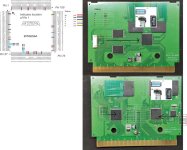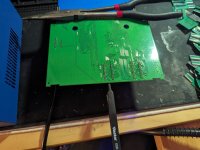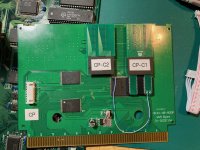Alright. So what are we building? @ack @Vortex @ArcadeTV and some other fine folks I'm forgetting in this moment (please chime in, I'll add you to the credits) reverse engineered, created a daughterboard capable of holding more games, and created an improved menu for the V3 MVS and AES 161-in-1 Multicarts.
Tons of details spanning the entire project here:
https://www.arcade-projects.com/thr...161-in-1-cartridge-to-change-rom-games.15069/
There was some discourse in that thread about the difficulty of this project, as well as things that should be considered pre-requisites of skill or whether a questions was "technical enough" to bother answering. I think that's in bad form, and I genuinely believe anyone willing to put some time in and who can already through-hole solder without butchering things is entirely capable of this. So I'm going to be as explicit as I can in how to make one of these, and hope you have fun following along. After it's written, if you run into issues, feel free to post questions, nothing is too simplistic.
Repositories you'll need:
https://github.com/xvortex/VTXCart/tree/main
https://github.com/jwestfall69/neogeo-161in1-daughterboard/releases
https://github.com/jwestfall69/neogeo-161in1-dual-daughterboard
https://github.com/ArcadeTV/neogeo-menu
Tools you'll need (with my recommendations):
Solder (try to stay at 0.20 or below) - Kester 24-6337-0010
Flux paste - MG Chemicals 8341
Some sort of brush for the paste
Desoldering iron
Soldering iron
Hot air (with separate heat and air controls)
6mm tip for hot air station
Some sort of JTAG Programmer, any will do
Heat resistant gloves
Isopropyl alcohol (99% or 91%)
ESD Safe tweezers (needle-nosed AND a wide flat set)
Recommended but not necessary:
Hot plate
Items you'll need:
V3 Neo-geo multicart (AES or MVS)
1.27mm 2x25 or 2x50 pin rows (will be cut down to 2x22)
1.27mm 2x25 or 2x50 female pin headers (will be cut down to 2x22)
WeAct STM32H750 (you NEED a model with the screen)
2.54mm 2x25 or 2x50 female pin headers (will be cut down to 2x22)
PCBs you need to order (I recommend JLCPCB):
1 of each dumper board from Vortex's github (P, SM, and CV_DIP)
1 dual daughterboard from Ack's github
2 single daughterboards from Ack's github
I'll keep updating this as time permits. And I'm going to snag the next few posts here for the rest of the guide.
Tons of details spanning the entire project here:
https://www.arcade-projects.com/thr...161-in-1-cartridge-to-change-rom-games.15069/
There was some discourse in that thread about the difficulty of this project, as well as things that should be considered pre-requisites of skill or whether a questions was "technical enough" to bother answering. I think that's in bad form, and I genuinely believe anyone willing to put some time in and who can already through-hole solder without butchering things is entirely capable of this. So I'm going to be as explicit as I can in how to make one of these, and hope you have fun following along. After it's written, if you run into issues, feel free to post questions, nothing is too simplistic.
Repositories you'll need:
https://github.com/xvortex/VTXCart/tree/main
https://github.com/jwestfall69/neogeo-161in1-daughterboard/releases
https://github.com/jwestfall69/neogeo-161in1-dual-daughterboard
https://github.com/ArcadeTV/neogeo-menu
Tools you'll need (with my recommendations):
Solder (try to stay at 0.20 or below) - Kester 24-6337-0010
Flux paste - MG Chemicals 8341
Some sort of brush for the paste
Desoldering iron
Soldering iron
Hot air (with separate heat and air controls)
6mm tip for hot air station
Some sort of JTAG Programmer, any will do
Heat resistant gloves
Isopropyl alcohol (99% or 91%)
ESD Safe tweezers (needle-nosed AND a wide flat set)
Recommended but not necessary:
Hot plate
Items you'll need:
V3 Neo-geo multicart (AES or MVS)
1.27mm 2x25 or 2x50 pin rows (will be cut down to 2x22)
1.27mm 2x25 or 2x50 female pin headers (will be cut down to 2x22)
WeAct STM32H750 (you NEED a model with the screen)
2.54mm 2x25 or 2x50 female pin headers (will be cut down to 2x22)
PCBs you need to order (I recommend JLCPCB):
1 of each dumper board from Vortex's github (P, SM, and CV_DIP)
1 dual daughterboard from Ack's github
2 single daughterboards from Ack's github
I'll keep updating this as time permits. And I'm going to snag the next few posts here for the rest of the guide.
Last edited:




